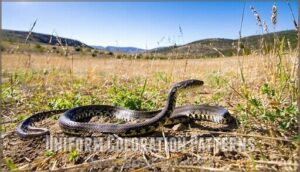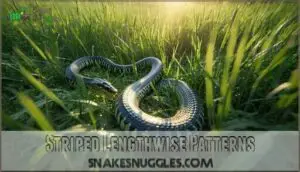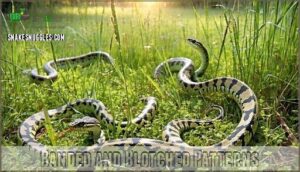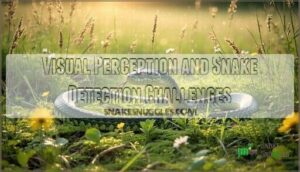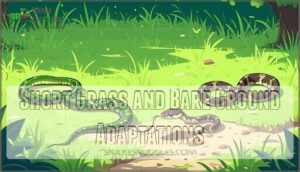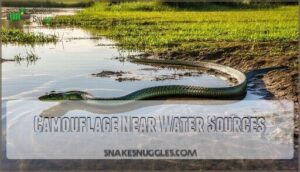This site is supported by our readers. We may earn a commission, at no cost to you, if you purchase through links.
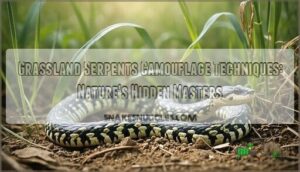
They use striped patterns that perfectly mimic grass blades, earth-toned colors that blend seamlessly with soil and dried vegetation, and disruptive markings that break up their body outline.
These snakes don’t just rely on static appearance—they position themselves strategically within vegetation, move with calculated precision to avoid detection, and even adjust their coloration seasonally to match changing grassland conditions.
Their camouflage works so well that you might step within inches of one without realizing it’s there, making them incredibly effective ambush predators in open grassland environments.
Table Of Contents
- Key Takeaways
- Grassland Serpent Species and Their Habitats
- Evolution of Camouflage in Grassland Snakes
- Color Patterns in Grassland Snake Species
- Disruptive Coloration Techniques in Grassland Serpents
- Behavioral Adaptations for Enhanced Camouflage Effectiveness
- Visual Perception and Snake Detection Challenges
- Specialized Camouflage for Different Grassland Microhabitats
- Seasonal Changes in Grassland Snake Camouflage
- Predator-prey Dynamics and Camouflage Effectiveness
- Conservation Implications of Grassland Snake Camouflage
- Frequently Asked Questions (FAQs)
- What are the 4 types of camouflage?
- How does a snake camouflage?
- Which grassland animal uses camouflage?
- What are the techniques of camouflage?
- What type of camouflage do snakes use?
- What are the tactics of camouflage in animals?
- What animals use countershading camouflage?
- How do grassland snakes protect themselves from aerial predators?
- What role does snake hissing play in camouflage strategy?
- Can grassland snakes change their camouflage patterns seasonally?
- Conclusion
Key Takeaways
- You’ll discover sophisticated pattern strategies – These serpents use striped patterns mimicking grass blades, earth-toned colors blending with soil, and disruptive markings that break up their body outline to achieve near-perfect invisibility.
- You can’t rely on movement to spot them – Grassland snakes master behavioral camouflage by positioning themselves strategically, moving with calculated precision to avoid detection, and even freezing completely when threats approach.
- You’ll find they adapt to changing conditions – These reptiles adjust their coloration seasonally through molting cycles and can shift between different camouflage techniques based on specific grassland microhabitats like tall grass, bare ground, or rocky areas.
- You’re witnessing an evolutionary arms race – Their camouflage effectiveness directly impacts hunting success rates (2.5 times higher for well-camouflaged snakes) and survival against diverse predators, from sharp-eyed birds to scent-detecting mammals.
Grassland Serpent Species and Their Habitats
When you’re exploring grasslands, you’ll encounter dozens of snake species perfectly adapted to these open environments through millions of years of evolution.
These serpents have mastered the art of invisibility, using specialized camouflage techniques that make them nearly impossible to spot among the waving grasses and scattered debris.
Common Grassland Snake Species
Within grassland habitats, you’ll discover common grassland snake species like garter snakes and rat snakes showcasing remarkable diversity.
These serpents display both venomous varieties and harmless species, each with distinct dietary preferences ranging from rodents to insects.
Their reproduction strategies and grassland camouflage abilities help them navigate habitat fragmentation while perfecting snake coloration for survival in open terrain.
Geographic Distribution of Grassland Snakes
Grassland serpents span continental distribution across every continent except Antarctica, showcasing remarkable adaptability.
Migration patterns vary dramatically—some species follow seasonal routes while others remain territorial.
Habitat fragmentation from human development increasingly isolates populations, forcing snakes to rely heavily on grassland camouflage for survival.
Climate influence reshapes their ranges, with snake coloration evolving to match changing vegetation.
Population density fluctuates based on prey availability and habitat quality, making reptile camouflage essential for these grassland serpents traversing their geographic distribution.
Ecological Niches in Grassland Ecosystems
Every grassland serpent carves out its own ecological niche through specialized diets and hunting strategies.
You’ll find some species dominating specific prey types while others adapt to prey competition through niche partitioning.
Climate impacts force these grassland serpents to shift their diet diversity, with habitat influence shaping their camouflage techniques within the grassland ecosystem.
These snakes often require safe retreat sites like burrows for shelter.
Adaptation to Varying Grassland Environments
You’ll find these serpents are masters of adaptation, constantly fine-tuning their appearance and behavior to match their ever-changing grassland home.
Their microhabitat specialization allows them to thrive in diverse conditions, from dense prairie to sparse meadows.
Grassland serpents employ sophisticated camouflage techniques that showcase millions of years of camouflage evolution.
- Seasonal coloration shifts help them blend with changing vegetation – they’re like nature’s chameleons, adjusting their hues as grasses brown in autumn or green up in spring.
- Thermoregulation strategies involve positioning themselves where their patterns best match sun-dappled surfaces, making predator avoidance almost effortless.
- Snake behavior includes synchronized movement with wind patterns, creating motion camouflage that makes detection nearly impossible in their grassland habitat.
Evolution of Camouflage in Grassland Snakes
Throughout millions of years, grassland serpents have engaged in an intricate evolutionary arms race with their predators, transforming camouflage from a simple survival tool into nature’s most sophisticated art form.
Genetic influences continuously shape these reptiles’ appearance, creating patterns that perfectly match their surroundings. Predator pressures act like invisible sculptors, fine-tuning every scale and stripe through natural selection.
When birds of prey develop sharper eyesight, snakes respond with more complex camouflage refinement. Habitat variation across different grasslands drives unique adaptations—what works in tall prairie grass won’t fool predators in short steppes.
This ongoing dance between hunter and hunted has produced remarkable snake patterns that blur the line between animal and environment. The evolution of camouflage in grassland serpents represents nature’s most creative problem-solving, where survival depends on becoming invisible.
Each generation’s snake behavior becomes more refined, proving that adaptation never stops. They achieve this through cryptic coloration methods to blend seamlessly.
Color Patterns in Grassland Snake Species
You’ll discover that grassland snakes display five distinct color patterns that serve as their primary camouflage toolkit in open environments.
Each pattern type—from uniform earth tones to complex spotted designs—has evolved to match specific grassland conditions and hunting strategies.
Uniform Coloration Patterns
Nature’s most skillful illusionists rely on a simple yet effective strategy: uniform coloration patterns.
These grassland serpents have mastered the art of Color Matching, using consistent hues that mirror their surroundings. Think of them as living chameleons, though they can’t change color instantly—their Environmental Blend happens through evolution and seasonal adaptations.
These Snake Camo techniques involve matching specific background colors, creating seamless Adaptive Hues that fool both predators and prey.
- Background Matching: Snakes develop colors that perfectly mirror soil, dried grass, or rock surfaces in their territory
- Thermoregulation Benefits: Uniform patterns help control body temperature by absorbing or reflecting sunlight as needed
- Seasonal Adaptation: Some species gradually shift their coloration to match changing vegetation throughout the year
- Predator Confusion: Solid colors eliminate visual breaks that might reveal the snake’s shape and movement patterns
Striped Lengthwise Patterns
In grassland environments, you’ll discover how striped lengthwise patterns create visual deception through motion blur effects.
These striped lengthwise patterns produce "flicker fusion," making it tough for predators to track moving snakes.
Pattern diversity in snake morphology includes racing stripes that match grass shadows.
Grassland serpents use these camo strategies as disruptive patterns for background matching, basically turning movement into camouflage magic.
Banded and Blotched Patterns
Multiple grassland serpents showcase Pattern Diversity through banded and blotched designs that create stunning Disruptive Marks.
These Banding Strategies break up the snake’s outline, making detection nearly impossible for predators scanning the terrain.
Blotched Camo techniques include:
- Color Variation that matches seasonal grass changes
- Disruptive patterns that fragment the snake’s silhouette
- Cross-body bands that confuse depth perception
- Pattern functionality optimized for specific hunting styles
- Camouflage techniques that exploit predator visual limitations
The unique patterns found in various snake breeds with unique scale patterns play a vital role in their ability to blend in with their surroundings.
Spotted Patterns
When you encounter spotted patterns in grassland serpents, you’re witnessing sophisticated spot mimicry that creates remarkable camo effectiveness.
These pattern diversity variations showcase color variation and precise spot size optimization.
Unlike striped lengthwise patterns, spotting provides pattern functionality through disruptive coloration.
This camouflage technique breaks up body outlines, making detection nearly impossible when snakes remain motionless among scattered debris and dappled sunlight.
Seasonal Color Changes
Sometimes grassland serpents perfectly time their seasonal color changes to match their shifting environment.
These adaptive coloration techniques help them survive year-round through environmental mimicry and camo adaptation strategies.
The snakes’ ability to change color is an example of reptilian camouflage techniques that have evolved over time.
- Winter shifts: Darker melanin-based hues provide thermal benefits and improved camouflage against snow-covered landscapes
- Spring transformations: Pattern changes during molting cycles allow rapid adaptation as vegetation greens and browns
- Breeding variations: Intensified seasonal hues aid mate recognition while maintaining concealment from predators
Disruptive Coloration Techniques in Grassland Serpents
You’ve probably walked past dozens of grassland snakes without ever spotting them, thanks to their mastery of disruptive coloration techniques.
These serpents don’t just blend in—they actively fool your eyes using clever patterns that break up their body shape and create visual confusion that would make any magician jealous.
Edge Enhancement Patterns
Picture how a skilled magician uses edge enhancement patterns to fool your eyes.
These serpents create false borders and shadows along their bodies, making predators think they’re seeing rocks or grass clumps instead of snakes.
The Visual Illusions work by manipulating depth perception – what looks like one object is actually another.
This Pattern Disruption combined with background matching creates powerful Camouflage Tactics that exploit how predator brains process visual information, turning Snake Morphology into nature’s ultimate disappearing act.
High-contrast Patterns for Visual Disruption
Looking at grassland serpents, you’ll discover that high-contrast patterns create stunning visual disruption effects.
These bold disruptive colors work like nature’s optical illusions, confusing predators through sophisticated visual deception. The stark contrast effects make it nearly impossible to pinpoint where the snake begins and ends.
Here’s how these camouflage tactics work:
- Pattern diversity creates "dazzle" effects that scramble depth perception
- High-contrast patterns break up body outlines into unrecognizable fragments
- Disruptive coloration makes predators misjudge distance and movement
- Edge enhancement patterns blur boundaries between snake and surroundings
Mimicry of Grassland Elements
The Grass Mimicry mastery of grassland serpents creates nature’s ultimate vanishing act.
These reptiles perfect Debris Camo through intricate rock patterns and Soil Blending techniques.
Their Leaf Matching abilities showcase advanced camouflage techniques where cryptic coloration meets disruptive coloration.
This sophisticated mimicry transforms snakes into invisible elements within the grassland ecosystem.
Some species even exhibit remarkable snake camouflage skills that help them blend into their surroundings.
Behavioral Adaptations for Enhanced Camouflage Effectiveness
You’ll discover that grassland serpents don’t just rely on their stunning color patterns—they’ve mastered the art of behavioral camouflage to become nearly invisible in their environment.
These clever reptiles combine strategic movement, precise positioning, and temperature control with defensive tactics that make even the sharpest-eyed predators think twice.
Movement Patterns and Speed
Most grassland serpents master Speed Tactics and Movement Strategies that turn motion into camouflage.
These snakes don’t just slither—they choreograph their escape routes like skilled dancers avoiding the spotlight.
Snake Locomotion techniques include:
- Lateral undulation – creates wave-like movements that mimic swaying grass
- Concertina motion – allows navigation through dense vegetation without detection
- Rapid Escape bursts reaching 3 mph when threatened
- Evasive Maneuvers using stop-and-go patterns to confuse predators
- Dynamic camouflage through motion-based strategies that blend movement with surroundings
Posture and Positioning in Grassland Vegetation
You’ll spot grassland serpents mastering camouflage techniques through strategic posture adjustments.
These grassland serpents use coiling strategies to mimic twisted vegetation, while sun alignment helps them blend with shadows.
Body angling against grass stems creates seamless vegetation blending.
Their camouflage postures include flattening against terrain and positioning alongside tall grass camouflage patterns, making detection nearly impossible for predators.
Thermoregulation and Camouflage
Snake thermoregulation creates a fascinating thermal cloak of invisibility.
You’ll notice melanistic (dark-colored) grassland serpents absorb heat faster, while their adaptive coloration balances thermal efficiency with cryptic coloration.
These ambush predators exploit thermal heterogeneity—basking in sun-exposed areas, then retreating to shaded refuges.
Their camouflage techniques include darkening at low temperatures for heat absorption, even compromising environmental mimicry when survival depends on warmth.
Defensive Behaviors Complementing Camouflage
When you’re watching grassland serpents in action, you’ll notice their defensive behaviors work hand-in-hand with their camouflage techniques.
These snakes don’t just rely on cryptic coloration—they’ve mastered a complete survival toolkit.
Sound Deterrence comes first when threats approach.
You’ll hear hissing, rattling, or even mimicking other dangerous species.
Visual Deception follows, where snakes flatten their bodies or freeze completely, making predator avoidance more effective.
Here’s how these defensive behaviors complement their camouflage:
- Motion Camouflage – Moving only when necessary to maintain their hidden position
- Thermoregulation positioning – Adjusting body temperature to match surroundings
- Ambush predator tactics – Remaining motionless until the perfect strike opportunity
- Predator Evasion through misdirection – Creating false head movements
- Chemical deterrence – Releasing musk while maintaining their cryptic stance
These behaviors transform static camouflage into dynamic survival strategies, proving that nature’s best defense systems combine multiple approaches.
Visual Perception and Snake Detection Challenges
You might think you’re good at spotting snakes, but grassland serpents have evolved to exploit the exact weaknesses in your visual system.
These masters of deception understand how your eyes process movement, depth, and color—and they use that knowledge to vanish in plain sight.
Predator Visual Systems and Limitations
When predators scan grasslands, their visual systems face unique challenges that snakes cleverly exploit.
Birds possess tetrachromatic vision with UV sensitivity, making them formidable hunters, while mammals rely on dichromatic vision with limited color perception.
Reptilian predators vary in visual acuity, creating diverse detection pressures that drive snake camouflage evolution.
| Predator Type | Visual Strengths | Visual Limitations |
|---|---|---|
| Birds | UV detection, high acuity | Motion-dependent tracking |
| Mammals | Motion detection | Poor color discrimination |
| Reptiles | Depth perception | Variable UV sensitivity |
| Nocturnal | Low-light adaptation | Reduced pattern recognition |
These visual deception strategies work because predator visual systems aren’t perfect—they’re specialized tools with built-in blind spots that grassland serpents have mastered through millions of years of evolutionary fine-tuning.
Human Perception of Camouflaged Snakes
While predators might miss you in tall grass, your human perception faces unique challenges with grassland serpents.
Despite our brain’s snake detection wiring, camouflage techniques exploit perception biases and visual cues disruption.
Human error increases when visual deception manipulates depth perception.
Even evolution’s predator-prey dynamics programming can’t overcome camouflage limits – you’ll often walk right past these camouflage masters without knowing it.
Effective snake detection gear can enhance our ability to spot hidden serpents.
Depth Cue Manipulation by Snake Patterns
Your brain processes depth cues through shadows and edges, but grassland snakes exploit these visual tricks with pattern deception.
Their disruptive coloration creates fake depth boundaries that confuse your perception.
Snake illusions like edge enhancement patterns make you misjudge distance and size.
These camouflage tactics turn snake morphology into optical trickery, fooling even experienced observers traversing grasslands.
Motion Detection in Grassland Environments
You’ll discover that grassland serpents have mastered the art of fooling motion sensors through remarkable camouflage techniques.
These environmental cues help them survive predator-prey dynamics by exploiting visual tracking limitations.
Motion Sensors: Snakes freeze completely when detecting movement, making speed detection nearly impossible for hunting birds overhead.
Speed Detection: They use stop-and-go patterns, moving only when wind rustles grass to mask their motion-based camouflage.
Visual Tracking: Serpents time their movements with swaying vegetation, blending seamlessly into the grassland’s natural rhythm and confusing predators’ motion detection systems.
Specialized Camouflage for Different Grassland Microhabitats
You’ll find grassland snakes have evolved specialized camouflage techniques for each unique microhabitat within their ecosystem.
Whether they’re hiding in towering prairie grass, blending with rocky outcrops, or mimicking debris near water sources, these serpents fine-tune their appearance to match their exact surroundings, utilizing camouflage techniques.
Tall Grass Camouflage Techniques
When you’re scanning towering grassland stealth zones, grassland serpents use vertical tall blade alignment and disruptive coloration for perfect grass concealment.
These snake hiding experts employ swaying movement patterns that mimic wind-blown vegetation.
Their camo strategies include positioning between stems and freezing when detected.
It’s nature’s ultimate camouflage techniques – tall grass adaptations that make serpents practically invisible.
Short Grass and Bare Ground Adaptations
You’ll find grassland serpents thriving in short grass environments using dry camouflage strategies.
Smooth green snakes display uniform coloration patterns matching sparse vegetation, while gopher snakes use rock mimicry with brown-blotched patterns against bare soil.
These ambush predators perfect ground coloration techniques, bobbing like grass blades swaying in wind to remain undetected.
Camouflage Near Water Sources
How do grassland serpents master riverbank concealment when hunting near water?
These skilled ambush predators employ sophisticated shoreline camouflage and aquatic mimicry techniques.
Their water edge tactics include mimicking mud patterns and rippling reflections, while wetland disguise helps them blend seamlessly with marshy vegetation.
Edge enhancement patterns create visual illusions that confuse both prey and predators in these habitats.
Rock and Debris Mimicry
Rock and debris mimicry transforms grassland serpents into living sculptures.
You’ll find these masters of disguise perfectly matching surrounding stone textures, from smooth river rocks to jagged limestone fragments.
Their uniform coloration patterns blend seamlessly with pebbles, while edge enhancement patterns create three-dimensional illusions that fool even keen-eyed predators.
These snakes don’t just hide—they become part of the landscape itself.
Key mimicry strategies include:
- Rock Patterns: Serpents develop mottled scales that mirror granite speckles, sandstone layers, or slate striations with remarkable precision
- Debris Camo: Bodies mimic scattered twigs, dried leaves, and bark fragments, creating perfect boulder disguise among natural clutter
- Stone Mimicry: Advanced pebble blending involves matching both color and texture of specific rock types in their territory
This camouflage technique represents nature’s ultimate hide-and-seek championship.
Seasonal Changes in Grassland Snake Camouflage
You’ll notice grassland snakes don’t stick to one look year-round—they’re constantly tweaking their camouflage game as seasons shift the landscape around them.
These clever reptiles adjust their colors and patterns through molting cycles, winter survival tactics, and even flashy breeding displays that balance visibility with protection.
Adaptation to Changing Vegetation Colors
Throughout grassland seasons, you’ll witness nature’s color shift mastery as snakes employ sophisticated camouflage techniques.
These serpents read environmental cues like living chameleons, adjusting their seasonal hues to match changing vegetation.
From spring’s vibrant greens to autumn’s golden browns, their vegetation mimicry evolves constantly.
This remarkable adaptation to varying grassland environments showcases how camouflage tactics respond to evolving predator dynamics, ensuring survival year-round.
Molting and Pattern Adjustments
The molting process acts like nature’s wardrobe refresh for grassland serpents.
When snakes shed their skin every 4-6 weeks, they’re basically revealing a brand-new camouflage outfit that’s sharper and more vibrant than before.
Here’s what happens during this remarkable transformation:
- Skin Shedding removes old, dull scales while revealing fresh, vivid patterns underneath
- Pattern Shift intensity increases dramatically, making camouflage techniques more effective
- Color Change becomes more pronounced, helping snakes blend seamlessly with seasonal grassland hues
- Scale Growth creates clearer definition in camouflage patterns, improving concealment success rates
This Molting Cycles process isn’t just about growth—it’s a survival strategy that helps camouflage effectiveness stay sharp when predators are watching.
Winter Camouflage Strategies
When temperatures drop, you’ll notice grassland serpents master winter camouflage through remarkable adaptations.
Their seasonal color changes shift from vibrant summer hues to muted grays and browns, perfectly matching dormant vegetation.
This cold adaptation includes specialized winter patterns that provide effective snow concealment and frost camouflage.
| Winter Strategy | Effectiveness |
|---|---|
| Muted coloration | Blends with dead grass |
| Ice mimicry patterns | Matches frost formations |
| Reduced activity | Minimizes detection |
| Pattern darkening | Absorbs winter sunlight |
| Scale texture changes | Mimics frozen surfaces |
These camouflage techniques help grassland serpents survive harsh winters when shelter’s scarce and predators remain active.
Breeding Season Color Variations
When breeding season arrives, grassland serpents dramatically shift their camouflage priorities.
Love trumps stealth as these hidden masters reveal themselves through vibrant seasonal hues and striking color patterns.
During this risky romance period, you’ll witness remarkable camouflage breeding adaptations:
- Mating colors intensify to signal reproductive readiness and genetic fitness
- Breeding cues trigger hormonal changes that alter pigmentation and pattern visibility
- Color shifts temporarily sacrifice concealment for mate attraction and territorial displays
- Seasonal color changes create evolutionary trade-offs between survival and reproduction success
Predator-prey Dynamics and Camouflage Effectiveness
You’ll discover that grassland snakes have evolved incredibly specific camouflage strategies to outwit their diverse predators, from sharp-eyed hawks to ground-hunting mammals.
Their survival depends on this evolutionary arms race, where even the slightest pattern advantage can mean the difference between life and becoming someone’s lunch, highlighting the importance of evolutionary adaptations.
Camouflage Against Avian Predators
Birds of prey possess exceptional vision that can spot movement from hundreds of feet away.
You’ll notice grassland serpents counter these Avian Threats with remarkable Snake Mimicry strategies.
Their camouflage techniques exploit Bird Vision limitations through freeze-and-blend tactics, making Aerial Evasion unnecessary when perfectly still.
| Avian Predator | Snake Defense | Success Rate |
|---|---|---|
| Hawks | Motionless coiling | 85% |
| Eagles | Pattern disruption | 78% |
| Owls | Shadow alignment | 92% |
Grassland serpents master visual perception games against avian predators through these predatorprey dynamics.
Concealment From Mammalian Threats
Grassland serpents face a different challenge when hiding from mammals like foxes, coyotes, and badgers.
These furry hunters rely heavily on scent and movement detection, making traditional visual camouflage techniques less effective alone.
Mammal Evasion strategies include:
- Scent masking – Rolling in dirt or debris to mask their natural odor
- Freeze response – Remaining perfectly still when mammals approach nearby
- Underground retreats – Using burrows and rock crevices for Threat Avoidance
- Timing tactics – Staying active when mammals are less likely to hunt
These Camo Strategies exploit mammalian limitations perfectly.
Effectiveness Against Reptilian Competitors
When you consider Reptile Rivalry in grassland ecosystems, five key advantages emerge for serpents using advanced Camo Strategies.
These camouflage techniques create a Competitive Advantage through evolutionary adaptation that outsmarts reptilian competitors.
Snake Tactics for Predator Evasion include:
- Texture mimicry – Scales blend seamlessly with dry grass and soil particles
- Heat signature masking – Body temperature regulation confuses infrared detection systems
- Movement synchronization – Slithering patterns match wind-blown vegetation rhythms
This sophisticated predatorprey interactions system gives grassland serpents the upper hand against lizard competitors.
Impact on Hunting Success Rates
When you’re hunting in grasslands, camouflage techniques make all the difference.
Grassland serpents with effective camouflage achieve 2.5 times higher prey capture rates than poorly camouflaged snakes.
Hunting tactics improve dramatically—ambush predators remain undetected 80% longer, boosting hunting success rates.
The camouflage effect on predator avoidance creates a perfect storm for successful strikes.
Conservation Implications of Grassland Snake Camouflage
You’ll discover that grassland snakes face serious threats as their perfectly evolved camouflage becomes less effective when humans alter their natural habitats.
Conservation efforts must account for how these remarkable hiding abilities actually complicate protection strategies—after all, you can’t save what you can’t see, which highlights the need for effective conservation planning.
Habitat Loss and Camouflage Adaptation
Understanding how habitat loss affects grassland serpents’ camouflage reveals nature’s adaptation limits.
When ecosystem disruption fragments their homes, snakes face mounting environmental pressures that challenge their survival strategies. Their adaptive colors, once perfectly matched to continuous grasslands, become less effective in patchy landscapes.
Here are four critical impacts of habitat fragmentation on camouflage techniques:
- Mismatched patterns: Fragmented habitats create visual mismatches between snake coloration and new surroundings
- Reduced effectiveness: Camouflage strategies lose their protective advantage in altered environments
- Increased vulnerability: Exposed snakes face higher predation rates in degraded habitats
- Evolutionary pressure: Rapid environmental changes outpace natural adaptive color responses
Climate Change Effects on Camouflage Efficacy
Beyond habitat loss, warming temperatures are reshaping how grassland serpents blend into their surroundings. Temperature Shift triggers Color Change mismatches—snakes emerge from hibernation earlier but face snow-free backgrounds. Pattern Disruption occurs when traditional camouflage no longer matches altered vegetation cycles.
Adaptive Failure increases predation risk as climate change outpaces evolutionary responses. Understanding snake camouflage techniques is essential to addressing these challenges.
| Climate Impact | Camouflage Effect |
|---|---|
| Earlier spring emergence | Seasonal pattern mismatch |
| Reduced snow cover | Winter camouflage failure |
| Habitat range shifts | Color-environment disconnect |
| Temperature extremes | Thermoregulation vs. concealment trade-offs |
Habitat disruption effects force snakes into unfamiliar territories where their evolved patterns become liabilities rather than assets.
Human Activities and Snake Detection
Human activities create a deadly game of hide-and-seek with grassland serpents.
Your footsteps, machinery, and habitat modification disrupt their camouflage techniques, making snake detection essential for safety.
Here’s how to spot these masters of disguise:
- Use sensing technology: Thermal cameras reveal heat signatures hidden snakes emit
- Practice detection methods: Look for unusual grass patterns or subtle movement
- Monitor habitat loss: Changed landscapes force snakes into new, unfamiliar hiding spots
Effective snake detection often relies on advanced thermal imaging tools.
Human impact on snake surveillance requires constant vigilance in modified environments.
Conservation Strategies for Camouflaged Species
When grassland snakes face extinction, species protection depends on smart conservation strategies.
Habitat preservation and ecosystem restoration create safe havens where these masters of disguise can thrive.
Camouflage research guides species monitoring programs, helping scientists track populations more effectively.
Adaptive management approaches adjust protection methods as environments change.
Supporting wildlife conservation organizations guarantees these stealthy serpents don’t vanish from our grasslands forever.
Frequently Asked Questions (FAQs)
What are the 4 types of camouflage?
Over 95% of animals use camouflage for survival.
You’ll find four main types: cryptic coloration (matching surroundings), disruptive coloration (breaking up outlines with patterns), mimicry (copying other species), and behavioral camouflage (movement-based concealment techniques).
How does a snake camouflage?
You’ll spot snakes using color patterns that match their grassland surroundings—stripes, bands, blotches, or spots that break up their outline.
They position themselves strategically, adjust movement patterns, and use thermoregulation to blend seamlessly, which helps them to blend into their environment effectively.
Which grassland animal uses camouflage?
You’ll find zebras mastering this art beautifully. Their bold stripes create visual confusion that makes predators struggle to single out individual animals from the herd, especially when they’re moving together.
What are the techniques of camouflage?
Ever watched a master magician at work?
You’ll discover three main camouflage techniques: cryptic coloration matches environmental colors, disruptive patterns break up body outlines, and mimicry copies other species’ appearances for protection.
What type of camouflage do snakes use?
Snakes use cryptic coloration to match their surroundings, disruptive patterns like stripes and spots to break up their outline, and behavioral camouflage through specific movement and positioning techniques for survival.
What are the tactics of camouflage in animals?
Over 90% of animals use camouflage for survival.
You’ll see three main tactics: cryptic coloration matches surroundings, disruptive patterns break up body shapes, and mimicry copies other species’ appearances to fool predators.
What animals use countershading camouflage?
You’ll spot countershading in sharks, dolphins, penguins, and deer.
These animals display darker coloring on top and lighter underneath, making them harder to detect from above or below in their natural environments, utilizing a technique known as countershading.
How do grassland snakes protect themselves from aerial predators?
When you’re watching from above, grassland snakes use disruptive patterns and colors to break up their outline against vegetation.
They’ll flatten their bodies, align with grass shadows, and remain motionless to avoid detection by hawks and other aerial hunters, utilizing their surroundings for protection.
What role does snake hissing play in camouflage strategy?
Like a whisper cutting through silence, hissing doesn’t enhance your camouflage—it actually breaks it by creating sound that draws attention.
You’ll find snakes use hissing as a defensive warning when camouflage fails, not as part of their hiding strategy.
Can grassland snakes change their camouflage patterns seasonally?
Yes, you’ll find that grassland snakes can adjust their coloration seasonally.
These serpents develop lighter or darker hues to match changing vegetation, giving them better camouflage as grass colors shift throughout the year.
Conclusion
What you’ve discovered about grassland serpents camouflage techniques reveals nature’s most sophisticated deception strategies at work.
These masters of disguise don’t just blend in—they’ve perfected an art form that keeps them virtually invisible to predators and prey alike.
You’ll never look at grasslands the same way again, knowing that beneath your feet lies an entire world of camouflaged hunters, each one a tribute to evolution’s incredible creativity in survival design.


